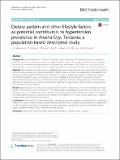| dc.description.abstract | Background: High blood pressure is increasing worldwide, disproportionately so in developing countries. Inadequate
health care systems and adoption of unhealthy lifestyles have been linked to this emergent pattern. To better understand
this trend, it is imperative we measure prevalence of hypertension, and examine specific risk factors, at a local level. This
study provides a cross-sectional view of urban residents of Arusha City to determine prevalence and associated risk factors.
Methods: Blood pressure was measured using a digital sphygmomanometer. Interviews were conducted using the WHO
STEPwise survey questionnaire to assess lifestyle factors. Dietary intake information was collected by a standardized Food
Frequency Questionnaire (FFQ). Descriptive statistics were used to analyze demographic characteristics. Means
and standard deviations were calculated for continuous variables and percentages for categorical variables.
Pearson’s Chi Square (χ2) tests were used to determine significant risk factors for hypertension, and multivariate
log binomial regression was used to reveal potential predictors of hypertension. Dietary patterns were analyzed
by principal component analysis.
Results: Approximately 45% of the study population was found to be hypertensive. The mean arterial blood pressure
(MABP) of the sample was 102.3 mmHg (SD = 18.3). Mean systolic and diastolic blood pressure were 136.3 (SD = 30.5)
and 85.3 (SD = 16.1) mmHg, respectively. Through multivariate analysis, age and body mass index were found to
be independently, positively, associated with hypertension. Adherence to ‘healthy’ dietary pattern was negatively
independently associated with hypertension.
Conclusions: With nearly half of participants being hypertensive, this study suggests that hypertension is a significant
health risk in Arusha, Tanzania. Obesity, healthy diet, and age were found to be positively associated with hypertension
risk. This study did not establish any significant association between increased blood pressure and Western-dietary
pattern, cigarette smoking, alcohol intake, and physical activities. | en_US |

